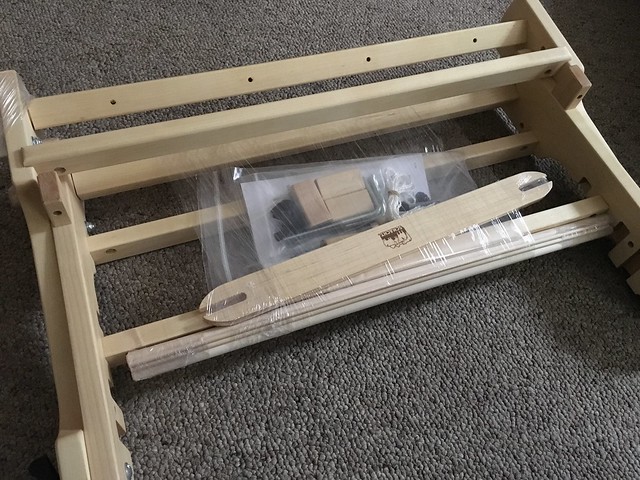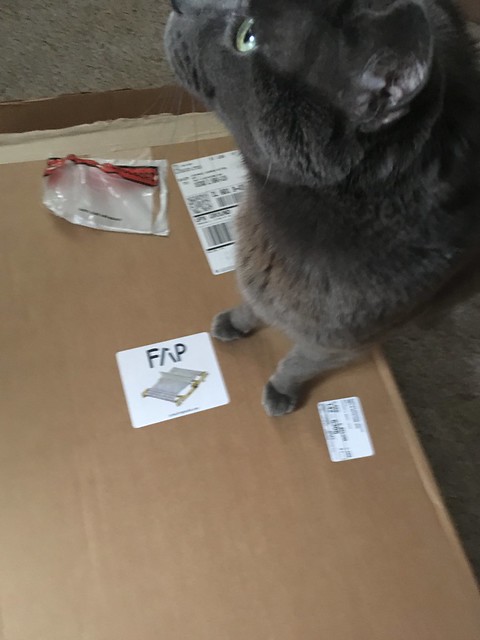For the past year or so, I'd been thinking about taking the plunge into weaving, and such thoughts have become quite serious in the past 6 months especially. When Syne Michell's book Inventive Weaving on a Little Loom came out, I'd heard such good things about it that I decided to put it on my Amazon Wish List with the hope that it would magically show up on my doorstep. It did, and it has turned the small little spark of "Maybe I should learn how to weave" into a roaring "Let's buy a loom and do this thing!"
It should be no surprise that not long after the holiday, I bought myself a loom! It didn't take long for my 20" Schacht Flip Rigid Heddle loom to arrive from Webs, and I've been slowly getting acquainted with it. There's a lot to learn!
I've done a lot of research to determine which loom I should get, and figured I should share my reasoning here for anyone who is interested in giving weaving a try but isn't sure where to start.
Initially, I had my heart set on a Schacht Cricket loom because it's affordable, compact and known for being user-friendly. I liked the idea of something that wouldn't take up too much room AND that wasn't a huge monetary commitment (the 15" Cricket is just under $200) - but then I became worried that I might begin to feel limited by such a small weaving width and that it might not be enough "loom" for me.
When I think back to how I started handspinning, I remember being frustrated by the limitations of the drop spindle fairly quickly - once I got my hands on a wheel, things started to come together and I became more engaged. My first spinning wheel wasn't particularly great, but it was enough to ignite the spark - then I got a really nice spinning wheel that suited me better (and a few years later, a second spinning wheel that I also enjoy spinning on), and that was that.
With that in mind, I wondered if I should just skip the "I'm too cheap to invest in something that might suit me better in the long run" step and just get a nicer loom - something that was still beginner friendly and relatively affordable, yet could also do more, provided I stuck with it to learn the skills to unlock the potential. In Syne Mitchell's book, she describes the Flip as an excellent teaching loom that holds good tension with a sturdy frame - and apparently, it's the only rigid-heddle loom with a second threading slot. I assume this is something that will be really exciting to me once I am able to weave a project that uses multiple heddles!
Lastly, I read somewhere that the projects you'd like to weave should help inform your choice in loom width. Seems pretty obvious, right?? I suppose, but for whatever reason, that hadn't quite clicked on in my brain. Honestly, what attracted me to weaving in the first place was that I heard it was a great way to use up your yarn stash quickly. I didn't really think too hard about what I would make, just that I would make it!
Once I thought about it more, I decided that projects such as scarves, tea towels, pillows bags and maybe even a small blanket would be the kinds of projects I would want to weave. While a 15" loom would probably serve my purposes well, it seemed like something that was a bit bigger would have more staying power. I'll let you know how sound this logic turns out to be, but that's more or less how I landed on the 20" width of the Schacht Flip.
Above is my brand new loom, fresh out of the box....which Robin enjoyed inspecting, of course. I think he approves?
I plan to share more of my (mis?)adventures with learning how to weave on future blog posts - next week I'll let you know how I fared getting it all set up for my first weaving project!
It should be no surprise that not long after the holiday, I bought myself a loom! It didn't take long for my 20" Schacht Flip Rigid Heddle loom to arrive from Webs, and I've been slowly getting acquainted with it. There's a lot to learn!
I've done a lot of research to determine which loom I should get, and figured I should share my reasoning here for anyone who is interested in giving weaving a try but isn't sure where to start.
Initially, I had my heart set on a Schacht Cricket loom because it's affordable, compact and known for being user-friendly. I liked the idea of something that wouldn't take up too much room AND that wasn't a huge monetary commitment (the 15" Cricket is just under $200) - but then I became worried that I might begin to feel limited by such a small weaving width and that it might not be enough "loom" for me.
When I think back to how I started handspinning, I remember being frustrated by the limitations of the drop spindle fairly quickly - once I got my hands on a wheel, things started to come together and I became more engaged. My first spinning wheel wasn't particularly great, but it was enough to ignite the spark - then I got a really nice spinning wheel that suited me better (and a few years later, a second spinning wheel that I also enjoy spinning on), and that was that.
With that in mind, I wondered if I should just skip the "I'm too cheap to invest in something that might suit me better in the long run" step and just get a nicer loom - something that was still beginner friendly and relatively affordable, yet could also do more, provided I stuck with it to learn the skills to unlock the potential. In Syne Mitchell's book, she describes the Flip as an excellent teaching loom that holds good tension with a sturdy frame - and apparently, it's the only rigid-heddle loom with a second threading slot. I assume this is something that will be really exciting to me once I am able to weave a project that uses multiple heddles!
 |
| The Schacht Flip Rigid Heddle Loom (photo from Webs site) |
Lastly, I read somewhere that the projects you'd like to weave should help inform your choice in loom width. Seems pretty obvious, right?? I suppose, but for whatever reason, that hadn't quite clicked on in my brain. Honestly, what attracted me to weaving in the first place was that I heard it was a great way to use up your yarn stash quickly. I didn't really think too hard about what I would make, just that I would make it!
Once I thought about it more, I decided that projects such as scarves, tea towels, pillows bags and maybe even a small blanket would be the kinds of projects I would want to weave. While a 15" loom would probably serve my purposes well, it seemed like something that was a bit bigger would have more staying power. I'll let you know how sound this logic turns out to be, but that's more or less how I landed on the 20" width of the Schacht Flip.
Above is my brand new loom, fresh out of the box....which Robin enjoyed inspecting, of course. I think he approves?
I plan to share more of my (mis?)adventures with learning how to weave on future blog posts - next week I'll let you know how I fared getting it all set up for my first weaving project!



Oooh!! Exciting! Can't wait to see more about this!
ReplyDelete